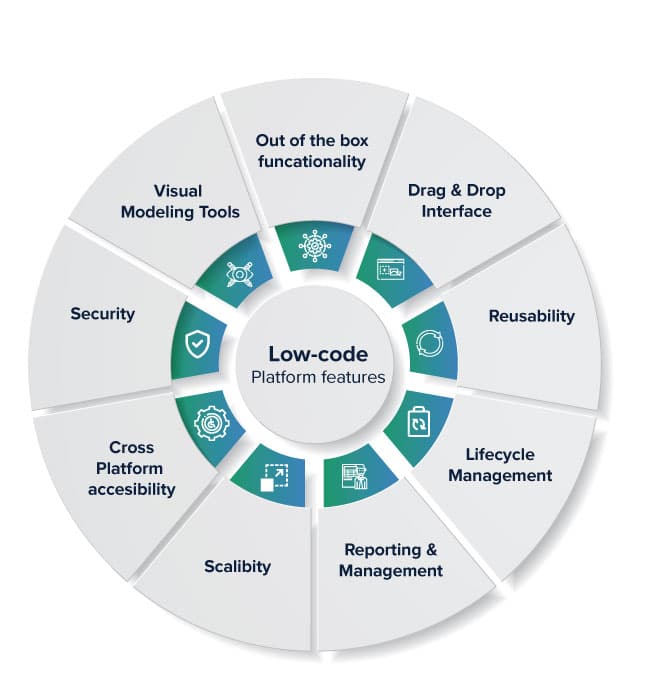Development of low-code applications significantly increases development speed due to several crucial factors. Development Environment:
Drag-and-Drop Interfaces: Low-code platforms provide visual tools for designing applications. Drag-and-drop elements allow developers to quickly build applications without having to write code.
Many low-code platform come with prebuilt templates and components. This allows developers to quickly build or prototype applications, without having start with a blank slate.
Reduced Coding Required:
Automated Code Generating: Low-code platform automatically generates the code underneath based upon the visual models that developers design. This helps reduce manual code, and speeds the process of developing.
Reusable component: Developers are able to make use of the same components in different projects. This cuts down time spent developing code and testing.
Streamlined Collaboration:
Integration of Development Tools: Low-code tools usually include tools for version control as well as testing and deployment that allow seamless collaboration between development teams.
Citizen Development (Citizen Development) Developers and users of business applications can take part in application development making use of intuitive interfaces. This can help reduce the burden caused by a lack of accessibility of professional developers.
Rapid Iteration and Prototyping
Rapid Prototyping: Developers design prototypes in a short time to validate ideas and collect feedback. This leads to shorter iteration cycle.
Easy Modifications: Low-code design is visually oriented, making it simpler to modify and update apps. It also speeds up the process for developing and improving applications in response to user feedback.
Pre-built Integrations:
API Integrations. A lot of low-code platforms have connectors built for popular APIs and services. This can speed up the process of integrating systems.
Data Integration: The integrated tools facilitate the process of connecting to databases and other sources, accelerating development.
Deployment and Scaling
One-Click Installation: A lot of low-code platforms provide the option of installing with one click which reduces the amount of effort and time needed to set up applications.
Cloud-Based Solutions: Cloud-based low-code platforms are able to handle scaling and infrastructure management and allow developers to focus on the logic of their applications and functions rather than deployment logistics.
The primary benefit of developing applications using low-code with regard to speed, is the ability to automatize and simplify many aspects of the process. This allows for rapid delivery of software and more rapid adaptation to changing requirements. View the best over at this website for Low-code Platform for application development for website examples including push notifications, low code development platforms, build a docker container, develop web application, cross platform app dev, develop web application, rapid application design, build with docker, application modernization software, cross platform mobile dev and more.

The Cost-Effectiveness Of Low-Code Development Is One Of The Main Benefits.
Low-code application development offers numerous advantages in terms of cost-effectiveness and efficiency, which makes it an appealing option for businesses looking to maximize their development budgets while still delivering top-quality software. These are the main benefits:
The low-code platform reduces the need for lengthy manual coding. This saves time and effort on the part of developers in developing their applications. This results in lower labor costs.
We need fewer resources for developers: Low-code programming is more efficient and quicker which means that less developers with specialization are required. This can reduce costs of recruiting and retaining personnel.
More Time To Market
Accelerated development cycle: Visual development tools and pre-built components offered by low-code platforms allow rapid application development. This allows companies to bring their products to launch faster. This could result in more revenue and sales and improved competitive positioning.
Rapid Prototyping: Businesses can quickly design prototypes and then test them, reducing the time required in the development phase and allowing for faster iterations that are based on feedback from the users.
Lower cost of maintenance:
Simpler Maintenance: Low-code platforms, with their modular components and standardised components, are easier to maintain. This reduces the ongoing maintenance and support cost.
Automated Patches and Updates: Low-code platforms are able to manage patching and updating applications completely. This ensures that the application is safe and always up to date without extensive manual intervention.
Efficient Resource Utilization:
Non-Developer Contributions: Low-code platforms allow people who are not developers to participate in the development process. This makes it possible for businesses to take advantage of the talents of a diverse variety of employees.
Optimized Use Of IT Resources IT teams can focus on strategic projects instead of getting bogged down with mundane development work, improving efficiency and productivity overall.
Price models that can be scaled:
Subscription-Based Pricing: A lot of low code platforms offer flexible pricing based on subscriptions that can scale depending on usage. This gives businesses the capability to match their spending to the growth of their business and its needs without the need for large upfront costs.
Pay-As-You-Go Options Certain platforms offer pay-as you-go options, which ensures that companies only pay for the resources they use and can be especially useful for small and new companies with a limited budget.
Reduce the cost of third-party software:
Built-in Functionalities: Low-code platforms usually come with built-in functionalities and integrations that reduce the need for additional third-party software and tools, which results in savings on licensing fees and subscription fees.
Pre-Built Integrations: Availability of pre-built integrations with popular platforms and services eliminates the requirement for custom development, thereby saving time and money.
Improved ROI:
A faster return on investment (ROI) Through combining rapid application development with reduced costs and a shorter time to market, companies are able to achieve an increase in ROI for their apps.
Enhanced Agility: Businesses can rapidly adapt to market trends and demands of their customers and ensure that they remain current and take advantage of emerging opportunities when they occur.
The cost of training is less:
User-Friendly Interfaces: The nimble user-friendly interfaces on low-code platforms reduce the learning curve for novice users, eliminating the need for lengthy training programs.
Accessible Resources: A lot of platforms using low-code provide an extensive range of instructional materials, tutorials, and support for community members. This reduces the requirement for formal education as well as the costs associated with it.
Streamlined collaboration:
Enhanced Collaboration Tools: The collaboration tools built-in to the software facilitate communication and coordination among team members. This leads to more efficient project development process as well as lower costs.
Unified Development Environment : A unified environment simplifies work flows and lowers the cost associated with managing various tools and platforms.
Overall, the efficiency of low-code software development can be attributed to its capacity to cut down on the cost of maintenance and development as well as increase the time to market as well as optimize the use of resources and offer flexible pricing models. These elements provide huge financial rewards to businesses. Low-code is a great option for businesses that want to increase budgets while still being able to develop robust, scalable and top-quality software. Take a look at the best Legacy application modernization with Low-code for site tips including application development platforms, software for app development, rapid app development, rapid app development, multiplatform mobile app development, cross platform mobile dev, database in azure, app modernisation, low code platforms, low code platforms and more.

Low-Code Apps Have Numerous Advantages When It Comes To Collaboration And Workflow
Low-code app development is an excellent choice for businesses who want to boost team productivity through streamlining development processes. Here are the major advantages: Improved Collaboration Across Functions:
Unified Development Environment : Low-code platforms offer a unified, single environment where team members are able to work efficiently including designers, business analysts, and other stakeholders. They eliminate silos and encourage greater communication.
Visual Development The platform's visual drag-and-drop features make it easy for team members who are not technical to be involved in the design process. It also ensures business requirements are captured correctly and then implemented.
Advanced Communication
Real-Time collaboration: Many low-code platforms offer real-time communication capabilities, such as simultaneous editing and commenting. Feedback is instantaneously accessible. This helps to reduce the amount of time needed to exchange information back and forth.
Workspaces shared by teams. Teams are able to collaborate on shared workspaces. Here, they can view, edit and discuss various project components.
Streamlined workflow management:
Built-in tools for managing projects Lowcode platforms usually come equipped with integrated tools that assist teams in planning, tracking, and coordinating their progress. This includes tasks management, progress tracking and management of deadlines.
Workflow Automation Automating repetitive tasks and workflows will reduce errors and efforts which allows employees to focus on more strategic work while increasing efficiency.
More Rapid Iteration:
Rapid prototyping. A low-code platform allows quick prototyping. This allows feedback to be quickly integrated and improvements are made.
Agile Development Support Supporting agile methods allows individuals and teams to work in smaller increments. It can also allow you to swiftly adapt to changes.
Accessibility for non-Developers
Citizen Development: Low code platforms enable users in the business (citizens developers) to develop and modify applications, with no extensive knowledge of coding. This eases the burden on IT and development teams and facilitates faster response to the business demands.
Onboarding and Training. The intuitive interfaces of the tools for training allow new members to be familiar with the system and this improves the teamwork.
Centralized Documentation & Knowledge Sharing
Documentation is integrated: Low code platforms are often equipped with tools to build and manage documentation on the platform, making it easy for all project details to be centralized.
Knowledge Repositories Teams are able to create and maintain repositories of knowledge that include best practice templates, templates and reusable elements, facilitating the sharing of information and reducing the amount of duplicate information.
Consistency Standards, Standardization and Consistency:
Standardized components: A standardized components, built in advance, ensures the consistency of the applications. Team members are able to understand and work better with different components.
Governance and compliance Governance and compliance: Integrated governance frameworks ensure that development adheres to regulations and standards of the organization. This decreases the chance of non-compliance, as well as helping applications meet quality standards.
Feedback Loops and Improvement Loops
Integrated Feedback Mechanisms Low-code platforms are usually equipped with integrated feedback mechanisms. They allow users to quickly provide feedback on the application that can then be integrated into the development process.
Continuous Improvement: The capacity to quickly test, deploy and change applications based on user feedback allows them to be aligned with business goals and user requirements.
Visualization, Reporting and Analysis
Real-Time Analytics built-in analytics and reporting tools give real-time insight into the progress of projects, their performance and user interaction which allow for data-driven decision-making.
Visual Workflow Mapping: Visual tools for mapping processes and workflows help teams understand and optimize their workflows, identifying gaps and areas to improve.
Overall, the advantages of developing low-code applications in terms of workflow and collaboration lie in its capacity to bring together diverse teams as well as streamline communication and streamline processes. This creates a more collaborative, efficient, and agile development environment that ultimately leads to better-performing applications and greater alignment with business goals.
